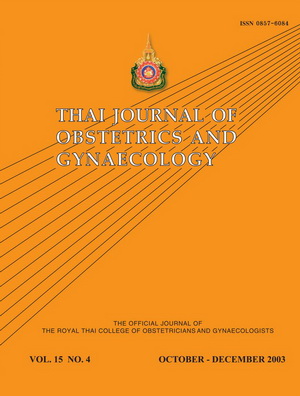Comparison of Tom Cat and PIVET Catheter for Intrauterine Insemination
Main Article Content
Abstract
Objective To compare immediate endometrial changes after IUI, pregnancy rates and difficulty in performing insemination using either Tom Cat or PIVET catheter.
Design A randomized trial.
Setting University Hospital.
Patients and Intervention Infertile couples (n=163) participated in 239 cycles of ovarian stimulaton and intrauteine insemiantion (IUI). Patients with bilateral tubal obstruction and severe male factor were excluded. Eligible patients were stratified into 2 groups by sonographic endometrial pattern (triple layer pattern present or absent). Patients in each group were randomized to either Tom Cat or Pivet catheters. Transvaginal sonography was repeated immediately after IUI in the former group and endometrial changes were recorded. All patients were followed for the outcomes of treatment.
Main outcome measurement Ultrasonographic endometrial changes, clinical pregnancy rates, technical difficulties and complications in performing IUI.
Results Pregnancy rates in both groups were not statistically different (12.9% in Tom Cat and
11.4% in PIVET group, p=0.714). Endometrial triple-layer pattern remained intact in 76.6% and 72.6% of cases after insemination using Tom Cat and PIVET catheter respectively (p=0.214). Difficulties and complications were not statistically different. Endometrial thickness > 7.5 millimeters was the only factor that significantly predicted success of IUI (p=0.042, odds ratio = 3.7; 95% CI = 1.1 - 11.9).
Conclusion Tom Cat and PIVET catheters are equally effective for IUI.


